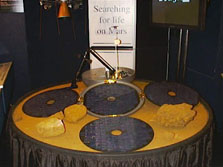




Searching
for Life on Mars
The Life Test Experiments
The
Viking Missions 
In the popular imagination, Mars has been the favored place for alien life since the nineteenth century. By the time the early Mariner spacecraft arrived at Mars in the 1960's, many of the general public were expecting to see a planet teeming with plant and animal, if not intelligent, life. They were sadly disappointed. Scientists, however, soon realized that while advanced life - animal and plant-like entities - would be extremely unlikely, there was more reason to think that microbial or simple life might exist on the Red Planet, or at least may have existed there in the past. The photographs from the Mariner series of spacecraft, ( Mariner 6, Mariner 7 and Mariner 9) showed evidence that water once flowed in abundance on the Martian surface. Vast river systems, flooded plains and even ocean basins were in evidence. But these were clearly all dry at the present time. No sign of liquid water, or what happened to it. Planetary scientists speculate that it is either concentrated at the polar caps as ice, it is frozen below the Martian surface as permafrost and hidden by overlaying dust and soil, or that it has evaporated or otherwise lost into space. So it was thought that if life existed it may not be currently active, but dormant and could be revived given the right conditions - for example heat and nutrients. Alternatively, dead life in the form of fossils may be present on Mars. It was speculated that these could be found in rock formations, but would most likely be very small - microscopic, in fact. Viewing such specimens would require microscopes.
|
|
|
The first successful soft-landings by the Viking spacecraft carried out a series of tests for life, and these have been somewhat controversial ever since. The official view, and the one to which most scientists currently subscribe, is that the tests were negative or at best inconclusive. However, since the Viking missions, there has been something of a revolution in our understanding of life and life processes. It is now accepted that microbial life can exist in what we think of as the most inhospitable of environments (see Extremophiles). Mars is one such environment and there has been an unofficial re-examination of the Viking data over the past few years. An interesting question to ponder is - how we would interpret the Viking results if they were new today? The first Viking lander produced positive results but the second produced no results, but it is claimed that inorganic peroxides could also produce positive results in the test. The official conclusion was that peroxides were present on the Martian surface. The NASA scientist who designed the tests, Dr Gilbert Levin, still maintains that the first test at least was positive (see A lesson from Huxley). Had the tests been carried out on Earth and the same results been obtained, then the inevitable conclusions would have been: yes! Life exists here! |
|
|
|
![]()
Protecting
Earth from space....
New
Life for the 'Mars Rock"
NASA
Mars Links page
Mars Exploration
New
Scientist Magazine Mars links
Biological Potential
of Mars
Life on Mars I
Life on Mars II
Return
to Mars - Children's page
|
The Next Generation of Spacecraft
|
|
|
In 1997 NASA successfully landed the Pathfinder probe and its mini rover Sojourner on Mars, and opened the way for a new phase of Mars exploration. Pathfinder was a great success and was followed by Mars Global Surveyor, which despite some early mishaps has produced spectacular results from its imaging system. In September 1999 Mars - Climate Orbiter arrived in the vicinity of Mars, but was lost through mistakes in its orbital control calculations. None of these missions was designed to search specifically for life signs, but the next mission Mars - Polar Lander was designed with life experiments on board. This was due to touch down on Mars in December 1999, but as with its predecessor, it was lost. Future NASA missions include Mars 2001, Mars 2003 and Mars 2005 Of these, the last two are sample return missions and will require special precautions against the possible biological contamination of Earth by alien microbes. The Russian Space Agency is also planning a Martian Mission for 2005 to search for life. |
|
|
The
European Space Agency has
a Mars mission under development Mars
Express. It includes a lander vehicle called Beagle
2 which will touch down on the Red Planet some time around 2004.
Beagle is named after the ship that took Charles
Darwin on his voyage of discovery that led to "The
Origin of the Species" and the theory of evolution.
Its mission is to search for life in the Martian soil. It
will be equipped with cameras, a drilling arm, and spectroscopes
for chemical and mineral analysis. Soil samples will be collected
from below the surface, at depths safe from solar radiation and
the harsh oxidizing conditions above ground. Samples will
be analyzed for the presence of organic molecules, and if any are
found their elemental isotopes and chirality will be investigated. |
|
|
New
Tests PCR's speedy multiplication process - called amplification - enables identical quantities of DNA material to be produced in a short time. The process is easy to carry out and highly reliable. It is in regular use as a forensic investigation aid, now used in both criminal and civil legal actions. It has also changed evolutionary biology into a science supported by excellent experimental evidence. The historic relationships between species can now be worked out, with a high degree of accuracy. PCR is a technique that will be extremely useful in the search for life on Mars. When the Viking missions landed the technique was still seven years from being invented. But now NASA scientists at the Ames Research Center in San Jose, are working at developing the technique for use on Mars robot explorers. One is Rocco Mancinelli, a microbial ecologist/exobiologist working through the SETI Institute. The technique that is being developed uses differential thermal analysis coupled with gas chromatography. Tests and equipment development have been carried out using organisms in Yellowstone National Park and the Antarctic. It is assumed that if they exist, Martian microbes will be similar to these organisms and will behave in much the same way. One of the more advanced methods of analysis that will be used is PCR, and ways to use the technique on a Mars robot lander are being devised.
|
![]()
What
The Heck is PCR?
Making
PCR
What
is PCR?
|
Developments
in Spectroscopy How does this work? The reflected light that comes off an object has a particular color, or bands of color if we break the light into its color components with a prism. If we now shine the light through a small slit (known as a diffraction grating) and study the colors very closely we will see that there are tiny black lines and bright lines in the colors. It looks like a shopping bar-code and in fact, it can be used like a bar code too. Every chemical produces a unique set of lines and if you know the lines, you can identify the chemical.
|
|
|
Not only does this work for light, it works for X-rays and Gamma rays. With these we can not only look at the surface of an object, we can look inside it and find out what chemicals are in there. This works for organic chemicals as well as rock, gas or any material. Also in some cases, the spectrometer does not have to be very near the object being examined. Spectrometers are now essential pieces of equipment on planetary explorer and lander spacecraft. The image (left) of the rock Yogi and the Sojourner robot shows a spectrometer being held to the rock by the robot rover.
|
.....But going to Mars is not the only way to search for Martian life. There is an alternative approach...
© All images NASA, unless shown
Teachers Wormhole

Go
to
Home
| Space Station
| Mars | Rainforest
© 1999 Satellite Events Enterprises Inc.


